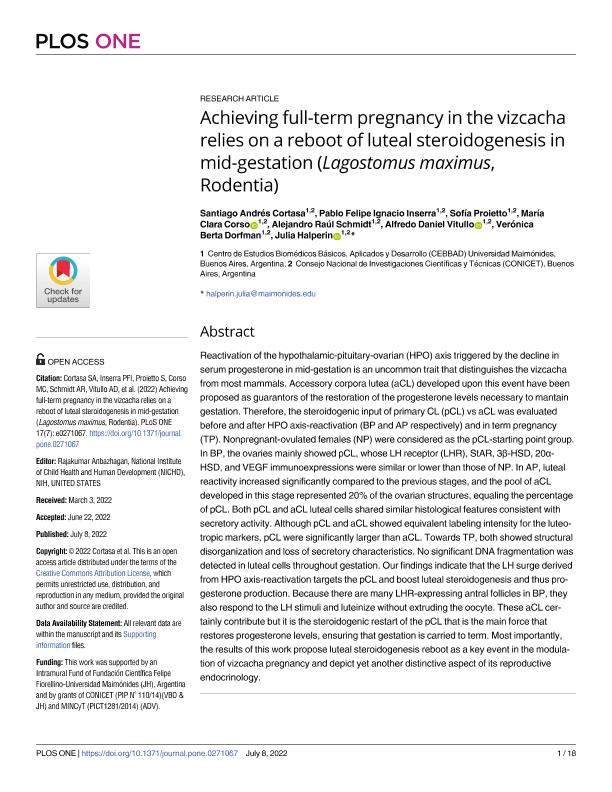Artículo
Achieving full-term pregnancy in the vizcacha relies on a reboot of luteal steroidogenesis in mid-gestation (Lagostomus maximus, Rodentia)
Cortasa, Santiago Andrés ; Inserra, Pablo Ignacio Felipe
; Inserra, Pablo Ignacio Felipe ; Proietto, Sofia
; Proietto, Sofia ; Corso, María Clara
; Corso, María Clara ; Schmidt, Alejandro Raúl
; Schmidt, Alejandro Raúl ; Vitullo, Alfredo Daniel
; Vitullo, Alfredo Daniel ; Dorfman, Verónica Berta
; Dorfman, Verónica Berta ; Halperin, Julia
; Halperin, Julia
 ; Inserra, Pablo Ignacio Felipe
; Inserra, Pablo Ignacio Felipe ; Proietto, Sofia
; Proietto, Sofia ; Corso, María Clara
; Corso, María Clara ; Schmidt, Alejandro Raúl
; Schmidt, Alejandro Raúl ; Vitullo, Alfredo Daniel
; Vitullo, Alfredo Daniel ; Dorfman, Verónica Berta
; Dorfman, Verónica Berta ; Halperin, Julia
; Halperin, Julia
Fecha de publicación:
07/2022
Editorial:
Public Library of Science
Revista:
Plos One
ISSN:
1932-6203
Idioma:
Inglés
Tipo de recurso:
Artículo publicado
Clasificación temática:
Resumen
Reactivation of the hypothalamic-pituitary-ovarian (HPO) axis triggered by the decline in serum progesterone in mid-gestation is an uncommon trait that distinguishes the vizcacha from most mammals. Accessory corpora lutea (aCL) developed upon this event have been proposed as guarantors of the restoration of the progesterone levels necessary to mantain gestation. Therefore, the steroidogenic input of primary CL (pCL) vs aCL was evaluated before and after HPO axis-reactivation (BP and AP respectively) and in term pregnancy (TP). Nonpregnant-ovulated females (NP) were considered as the pCL-starting point group. In BP, the ovaries mainly showed pCL, whose LH receptor (LHR), StAR, 3β-HSD, 20α- HSD, and VEGF immunoexpressions were similar or lower than those of NP. In AP, luteal reactivity increased significantly compared to the previous stages, and the pool of aCL developed in this stage represented 20% of the ovarian structures, equaling the percentage of pCL. Both pCL and aCL luteal cells shared similar histological features consistent with secretory activity. Although pCL and aCL showed equivalent labeling intensity for the luteotropic markers, pCL were significantly larger than aCL. Towards TP, both showed structural disorganization and loss of secretory characteristics. No significant DNA fragmentation was detected in luteal cells throughout gestation. Our findings indicate that the LH surge derived from HPO axis-reactivation targets the pCL and boost luteal steroidogenesis and thus progesterone production. Because there are many LHR-expressing antral follicles in BP, they also respond to the LH stimuli and luteinize without extruding the oocyte. These aCL certainly contribute but it is the steroidogenic restart of the pCL that is the main force that restores progesterone levels, ensuring that gestation is carried to term. Most importantly, the results of this work propose luteal steroidogenesis reboot as a key event in the modulation of vizcacha pregnancy and depict yet another distinctive aspect of its reproductive endocrinology.
Palabras clave:
ovary
,
pregnancy
,
corpus luteum
,
progesterone
,
vizcacha
Archivos asociados
Licencia
Identificadores
Colecciones
Articulos(SEDE CENTRAL)
Articulos de SEDE CENTRAL
Articulos de SEDE CENTRAL
Citación
Cortasa, Santiago Andrés; Inserra, Pablo Ignacio Felipe; Proietto, Sofia; Corso, María Clara; Schmidt, Alejandro Raúl; et al.; Achieving full-term pregnancy in the vizcacha relies on a reboot of luteal steroidogenesis in mid-gestation (Lagostomus maximus, Rodentia); Public Library of Science; Plos One; 17; 7-2022; 1-18
Compartir
Altmétricas



